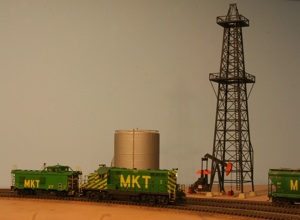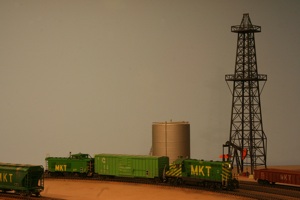Kevin Leyerle’s Oklahoma Kansas & Texas (OKT)
HO
600 Sq. Feet
MKT operations on the former Rock Island in Central Oklahoma
Walk In
Main line run: 120 Feet
Height: 52"
No scenery completed yet. Temporary mock-ups of some buildings are in place.
Easy DCC with Wireless Throttles
Stairs to basement. Wheel chair access is available through garage.
Car Cards and Waybills. Some switch lists are used.
Fast clock ratio: 4 to 1
Number of operators:Nine (9)
Job Descriptions:
Oklahoma City - Harter Yard Yardmaster
Oklahoma City - Harter/Turner Industry Job
Oklahoma City "OK Rail" Industry Job
El Reno, Oklahoma Yardmaster
Four (4) Road Crews (Road Trains and Locals)
Train Dispatcher
When the Rock Island Railroad (RI) went bankrupt in 1980, the Missouri-Kansas-Texas Railroad (MKT or Katy) assumed operations of the RI’s East/West line from McAlester, Oklahoma to Oklahoma City, Oklahoma. Katy established a subsidiary called the Oklahoma, Kansas and Texas (OKT) to operate the line west from Oklahoma City to El Reno, Oklahoma and to operate the former RI North/South line from Herington, Kansas to Ft. Worth, Texas. This is the part of the Katy Railroad that I model. Since this operation was on ex RI track and run by mostly ex RI employees, it puts a little different spin on the Katy.
The main focus of the layout is the switching and operations that took place at Oklahoma City’s Harter Yard. From there, MKT trains run east to Shawnee, Oklahoma where there is a large milling company to service. The Santa Fe Railroad had trackage rights here and also runs a local to Shawnee. OKT trains run west to El Reno, Oklahoma where they meet the North/South OKT line. A yard job at El Reno is kept busy blocking cars for trains and serving local industries there. Since the MKT/OKT is using the former RI yards and facilities in ways they were not really designed for, it makes for some interesting operations.
Dispatching is done via telephone. Road crews copy their own train orders using pre-filled train order forms. Main Track speed was 25 MPH. Yard and other tracks were10 MPH or less so operations are not fast paced. We will be running 12 or 13 trains during our Prairie Rail session.






